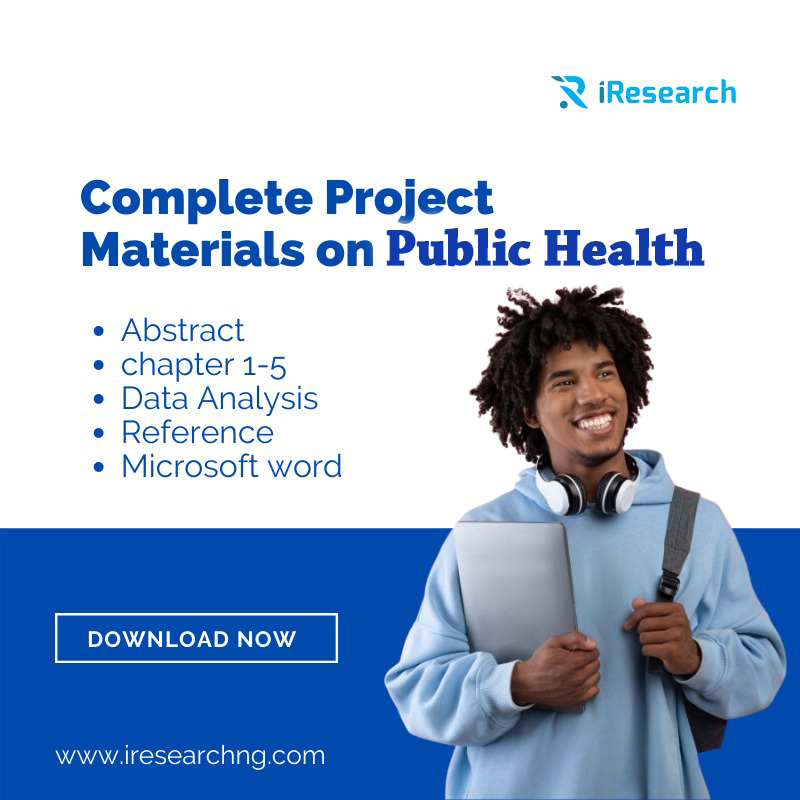



COMPARATIVE ANALYSIS OF PIPE BORNE WATER AND OTHER SOURCES OF WATER WITHIN ENUGU METROPOLIS
CHAPTER ONE
INTRODUCTION
Following the theory of creation, it is clear that water is as old as man. From time immemorial, man has restorted to the use of this unique commodity for domestic and other purposes.
Most of our water supplies are from surface water which include: rivers, streams, lakes, oceans and seas and there water bodies are likely to be polluted with domestic and Industrial as well as agriculture waste, As populations increase, the problem become more serious and as such, water can endanger the health and life of human beings because when polluted by fecal materials it becomes potential carrier of pathogenic organism (Carpenter 1977).
Water, is of course, absolutely essential to life, not only human life but all life, animal and vegetable. Most of the biochemical reaction that occur in metabolism and growth of living cells involved water, and all take places in water. (Camp etal,1974).
Man uses water not only for drinking purposes but also for bathing, washing, laundering, heating, air conditioning, agriculture, stock raising and gardens, Industrial processes and cooling water power and steam power, fire protection, fishing, swimming and wild life propagation and navigation.
Natural water contain not only then natural flora but also micro – organisms from soil and possible from animals or sewage. Surface waters in streams or pools and stored waters in lakes and large ponds vary considerably in microbial content. (frazier 1978) water is broadly divided into three types viz., surface water which include: streams, rivers, lakes sear, and oceans Kelman et al (1957)
The ground water, well borehle, many people have defined the ground water in different ways: ground water is subter water that occurs where all pores in the soil or rock counting materials are saturated (pelezer et al 1992).
The atmospheric water, which includes rain, falls. All water bodies consist of a variety of bacterial and other microorganisms like the Algaes fungi, which inhabit these natural water bodies. Some of these micro –organisms are indigenous to thus natural water while others are transient, entering the water from external environment (Pelezar and Reg, 1997).
The generality of bacteria are mostly commonly found ordinarily in fresh water some of which include: pseudomonas, Archacbacter, and vibrio these are gram negative, the gram-positive bacterial which are found in water include: micrococcus Archacbacter and actinomycentes. Gebharal (1975) Tap water, as one of the water sources is mostly used domestically, it is observed that tap change sometime the water tap will be clear this calls for load, in order to be sure of its portability. Bonde (1977)
The increase in drinking water from different sources especially in Enugu state has made necessary to investigate the microbial content of water. Water is a potential carried of pathogenic organisms that can endage human life. Most of drinking water sources are often contaminated with different pollutants like faces, animal and plant wastes, making such water unfit for drinking if not treated. The pollution of water with pathogenic organisms and other pollutants can only be detected by carrying out microbiological assessment of such water. Most human disease such as typhoid paratyphoid cholera, arnboebiasis, Trichinosis, gastroenteritis, sanonall shigellosis, diphtheria, giadia, dracunculus etc are know to be water borne disease. Ewington et al (1971).
Water born disease are those disease which have water as their vehicle of transmission these disease are capable of destroying a whole community if not checked. Therefore, the quickest ways to prevent out break of these disease and to determine the portability of such water sources is to determine the microbial load or content if the microbial content is nor within acceptable limit, such water sources should be condemned immediately. Fair et al (1970)
I. To find out if well, stream, Tap water coutain pathogens.
II. To help the public to know the danger of drinking these water without adequate treatment.
III. To compare the microbial load of the water source and advice on safer source of water .
STATEMENT OF PROBLEM
These source of water are contaminated through one way or the other
(i) The short falls in the distribution of treated pipe borne water leads people to resort to alternative source of water which may be unfit for human consumption
(ii) Tap water can be polluted through leakage’s/ improper plumbing.
(iii) Well water is contaminated as a result of running off into it, especially shallow well.
(iv) Streams can be contaminated through waste from industries, leaves, dust, and rain run often.
HYPOTHESIS
1. HO- pathogenic bacteria are present in water
2. H1- pathogenic bacteria are not present in water
3. Hiii- The level of pathogenic organism in water can cause water borne infection
4. Hilo The level of pathogenic organism in water can not cause watt born infection.
SIGNIFICANT OF STUDY
1) The study will advice on water meet the standard quality required for any particular purpose
2) Also advice the eswc on quality of their product. For future nature modification of treatment methods
NOT THE TOPIC YOU ARE LOOKING FOR?
Once payment is made, kindly send us your project topic, email address and payment name to +234 810 144 4147
Once payment is confirmed, Project materials will be sent to your email